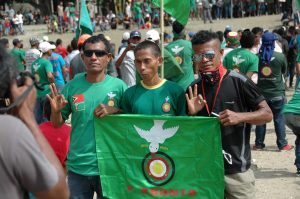For months, Timor-Leste has been embroiled in political crisis with two voting blocs competing for control of Parliament. On one side is Xanana Gusmao, the independence icon and powerbroker who leads the National Congress for Timorese Reconstruction (CNRT) through force of personality. On the other is Gusmao’s rival, President “Lu Olo” Guterres of the Fretilin party, and his former ally, the technocratic Prime Minister Taur Matan Ruak of the People’s Liberation Party (PLP), with whom Gusmao fell out in January.
In the middle of this power struggle stands KHUNTO.
A novice party with just five seats in Parliament, KHUNTO – which stands for “Enrich the National Unity of the Sons of Timor” – has come to play the role of kingmaker in Timor-Leste’s game of thrones.
Unexpectedly breaking ranks with Gusmao and the CNRT over whether to extend the pandemic-related lockdown, KHUNTO threw its support behind the fledgling PLP-Fretilin alliance in April. Its decision now gives Prime Minister Taur Matan Ruak a mandate to govern until 2023, which he could use to steer government spending away from its longtime focus on infrastructure mega-projects and toward basic development. It also signifies a stunning reversal of fortunes for Xanana Gusmao, a towering figure of Timorese politics who has served as president and prime minister but will now be in the opposition.
That KHUNTO cast the deciding vote is remarkable – not because of its size, but because of its constituency. KHUNTO is a political force unlike any other in Timor-Leste: a party that represents the interests of an outlawed martial arts group, and in turn, the growing population of disenfranchised young people from whom it attracts support. KHUNTO’s ascendancy is all the more extraordinary because martial arts groups have long occupied a fraught place in Timor-Leste, distrusted most for their contribution to the violence of the 2006 Timorese crisis. In 2013, then-Prime Minister Xanana Gusmao banned many of them outright. Yet today, the political wing of one of these martial arts groups has decided the fate of the government – and perhaps the direction of policy in Timor-Leste for years to come.
How exactly did martial arts groups go from the shadows to the political mainstream? Understanding their journey is important both for what it illuminates about Timor-Leste’s past and for what it might say about the future of its democracy. The story begins decades before Timorese independence, in the early days of Indonesian occupation.

































